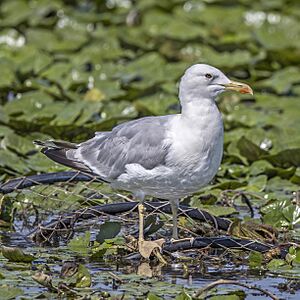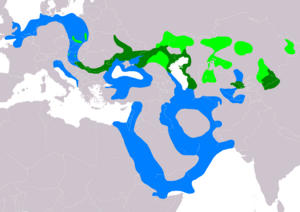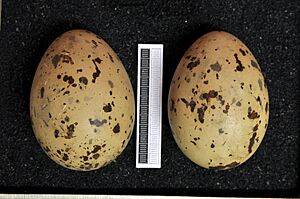Caspian gull facts for kids
Quick facts for kids Caspian gull |
|
|---|---|
 |
|
| Adult in summer plumage, Romania | |
| Conservation status | |
| Scientific classification | |
| Genus: |
Larus
|
| Species: |
cachinnans
|
 |
|
| Range of L. cachinnans Breeding Resident Non-breeding | |
The Caspian gull (Larus cachinnans) is a large type of gull. It's part of a group of gulls that includes the herring gull and lesser black-backed gull. Its scientific name comes from Latin. Larus means a gull or large seabird. Cachinnans means 'laughing', because of the sound it makes.
Contents
What Does a Caspian Gull Look Like?
The Caspian gull is a big bird. It can be about 56 to 68 centimeters (22 to 27 inches) long. Its wings can spread out from 137 to 155 centimeters (54 to 61 inches) wide. It weighs between 680 and 1590 grams (1.5 to 3.5 pounds).
This gull has a long, thin beak and a sloped forehead. Its legs, wings, and neck are longer than those of a herring gull. Its eyes are small and often dark. The legs can be pale pink or light yellowish. The back and wings are a bit darker gray than a herring gull. However, they are lighter than a yellow-legged gull. The tips of its outermost wing feathers are white.
Young Caspian gulls in their first winter have a pale head. They have dark stripes on the back of their neck. Their belly is pale, and their back is grayish. Their wing feathers have whitish tips. These tips form two light lines across the wing.
Where Do Caspian Gulls Live?
Caspian gulls breed around the Black Sea and Caspian Sea. Their breeding areas stretch east into Central Asia and northwest China. In Europe, they have been moving north and west. Now, they breed in Poland, eastern Germany, and southern Russia. They also live all year round in Ukraine.
Some Caspian gulls fly south for winter. They travel as far as the Red Sea and Persian Gulf. Others spread out into Western Europe. You can find them in countries like Sweden, Norway, and Denmark. They are also seen in the Benelux countries and northern France. Small numbers are now regularly seen in Britain. They are especially common in South-east England, East Anglia, and the Midlands.
Family Life of Caspian Gulls
Caspian gulls usually build their nests on flat, low ground near water. This is different from the yellow-legged gull. Yellow-legged gulls often nest on cliffs. The breeding season for Caspian gulls starts in early April.
Female gulls lay two or three eggs. Both parents take turns sitting on the eggs. This is called incubation. The eggs hatch after 27 to 31 days.
What Do Caspian Gulls Eat?
Caspian gulls are scavengers and predators. This means they eat many different things. They will eat leftover food and hunt for prey. During the breeding season, they often eat rodents. For example, they hunt ground squirrels. They might fly far into the grasslands to find them.
The Caspian Gull Family Tree
The way scientists classify the Caspian gull has changed over time. It used to be considered a subspecies of the herring gull. But now, many experts believe it is its own separate species. This includes groups like the British Ornithologists' Union.
Some experts also used to group the yellow-legged gull (L. michahellis) with the Caspian gull. However, it is now usually seen as a separate species too.
The steppe gull (L. (cachinnans) barabensis) is very similar to the Caspian gull. Some people think it's a subspecies of the Caspian gull. Others think it's a separate species. It breeds in Central Asia, especially northern Kazakhstan. We don't know much about where it goes in winter. Most are thought to spend winter in southwestern Asia. This area stretches from the Persian Gulf to northwestern India.
The Mongolian gull (L. (vegae/cachinnans) mongolicus) is another related bird. It might be a subspecies of the Caspian gull or the Vega gull. Or it could be its own species. It breeds in Mongolia and nearby areas. In winter, it flies southeast.
Images for kids







